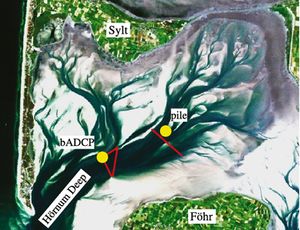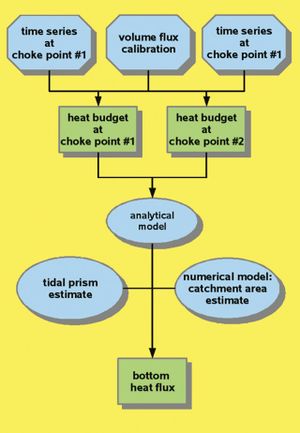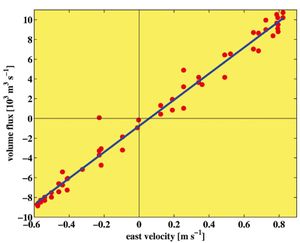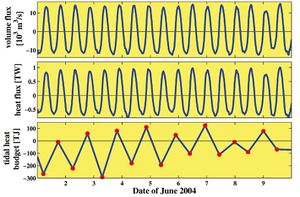Difference between revisions of "The heat budget of tidal flats"
Dronkers J (talk | contribs) |
|||
| Line 38: | Line 38: | ||
|AuthorName=Username}} | |AuthorName=Username}} | ||
| − | [[Category: | + | [[Category:Coastal and marine observation and monitoring]] |
| − | [[Category: | + | [[Category:Observation of physical parameters]] |
| − | [[Category: | + | [[Category:Physical coastal and marine processes]] |
| + | [[Category:Hydrodynamics]] | ||
Revision as of 21:12, 29 June 2019
Introduction
A major objective of the research programme is to develop methods to monitor and quantify exchange processes between the Wadden Sea and the North Sea. The generic approach is to acquire high-frequency time series of basic physical quantities at choke points, i.e. in tidal inlets or tidal channels, to evaluate the present horizontal fluxes of heat, freshwater or suspended particulate matter (SPM), and then to integrate the fluxes between two consecutive low tides. This yields the tidal budget of the corresponding quantity for the upstream area. An intrinsic problem of this method is to interprete the measurements at the choke points in terms of volume fluxes being representative for the entire inlet or channel, respectively. Here, the whole method is exemplified for heat fluxes (Fig. 2).
Methods and Techniques
Time series are available from measuring piles located in the East Frisian Wadden Sea and in the Hörnum tidal basin (see article "Dynamics and structure of the water and matter ex-change between the Wadden Sea and the German Bight"). The observations of the latter pile are complemented by time series from a bottom-mounted acoustic doppler current profiler (bADCP) located about 4 km southwest of the pile in the same tidal channel (Fig. 1); therefore, the above methods have been applied to the Hörnum basin.The present heat flux in the channel is proportional to the product of the volume flux and the temperature. Integration of the flux between two successive low tides yields the tidal heat budget. As can be seen from Fig. 4, the tidal budget exhibits oscillations with a doubletidal period, which is related to the diurnal cycle of heating and cooling of the tidal flats. The diurnal cycle, together with the fortnightly inequality, are filtered out by averaging the budget with a running mean over one month The heat budget in the open ocean is solely controlled by advection and the net heat flux between the ocean and the atmosphere. In comparison, the heat budget in tidal flats is additionally impacted by the bottom heat flux between the sea bed and the overlying water column. An analytical model was developed, which in conjunction with a numerical transport model for the determination of the respective catchment area yields estimates of the bottom heat flux in dependency of the tidal heat budgets at the two time series stations. Both for the bADCP and the pile, the heat budget of the respective catchment area was evaluated for the year 2004 between the middle of March and late October, and the bottom heat flux was determined for the same period.
Results and Outlook
Fig. 5 shows that the budget at the bADCP is negative from April through the middle of August, hence relative to this choke point the upstream tidal flat area is exporting heat. From August the budget becomes positive which means import of heat. At the pile, the situation is reversed: the budget is positive from March through late August (import), and switches to an export situation in autumn. This is because during night time a fraction of the incoming water is releasing heat to the colder tidal flats. The relative contribution of that fraction being in contact with the flats is higher at the pile than at the bADCP. This is illustrated in Fig. 6. Corresponding evaluations of the mean heat budget for the years 2005 and 2006 show that the budgets exhibit interannual variations but the gross behaviour is similar among those years. Presently, work is in progress to validate the results achieved so far by direct measurements of the sediment temperature of the tidal flats. Further on, the described method is being applied to determine the budgets of freshwater and SPM.
Please note that others may also have edited the contents of this article.
|
Please note that others may also have edited the contents of this article.
|
Please note that others may also have edited the contents of this article.
|
Please note that others may also have edited the contents of this article.
|





